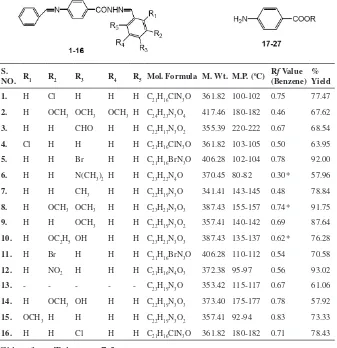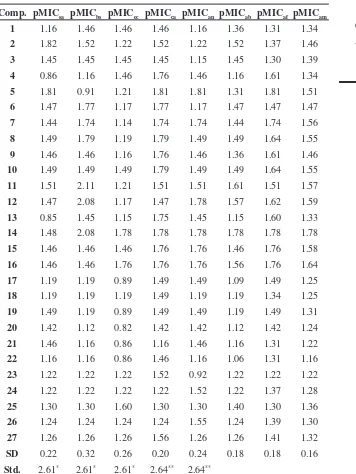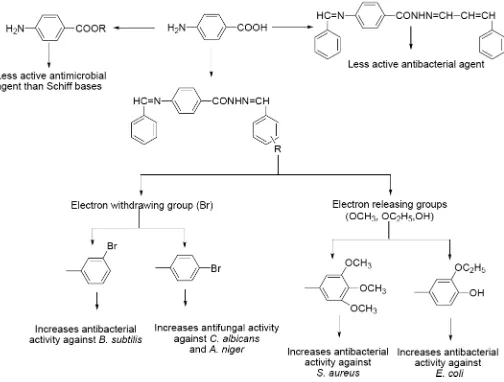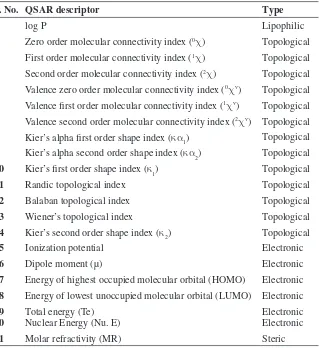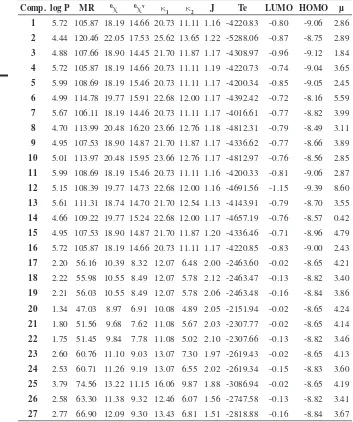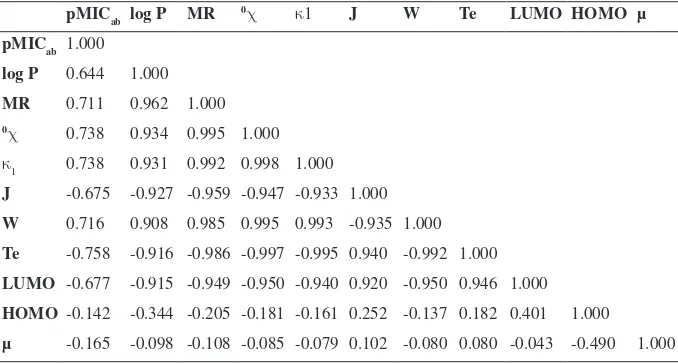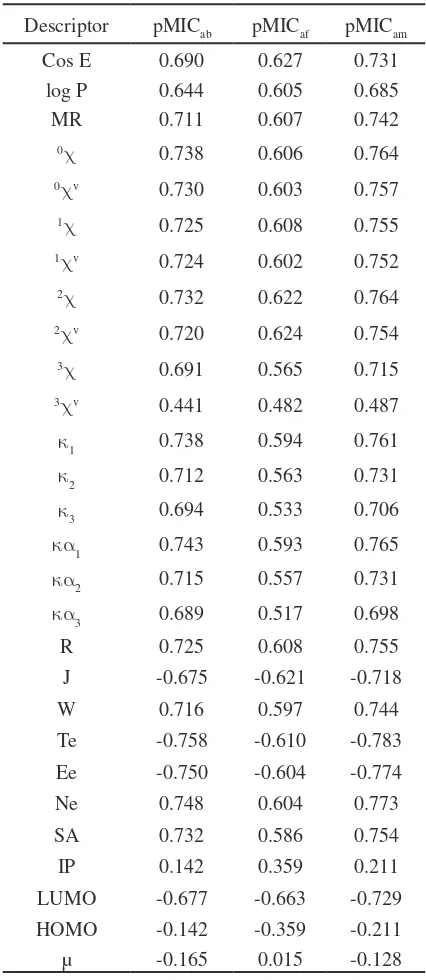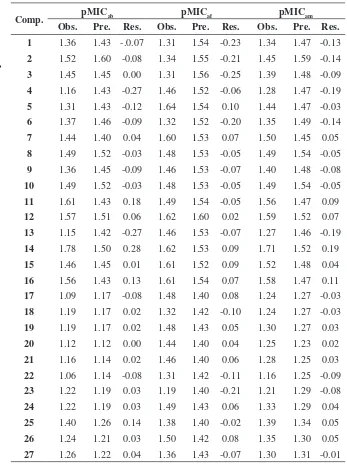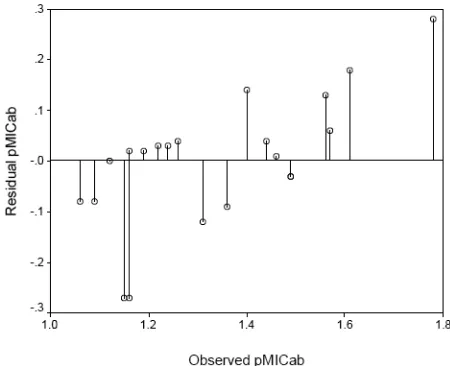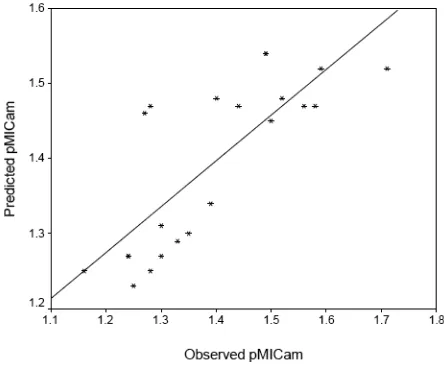Journal of Pharmaceutical Technology, Research and Management Vol. 2, No. 1, May 2014 pp. 87–104
©2014 by Chitkara University. All Rights Reserved.
DOI: 10.15415/jptrm.2014.21007
Synthesis, antimicrobial evaluation and QSAR
studies of p-amino benzoic acid derivatives
MEETA, PRADEEP KUMAR, BALASUBRAMANIAN NARASIMHAN*
Faculty of Pharmaceutical Sciences, Maharshi Dayanand University, Rohtak-124001, India.
*Email: naru2000us@yahoo.com
Abstract A series of Schiff bases (1-16) and esters (17-27) of p-amino benzoic acid (PABA) was synthesized and its in vitro antimicrobial potential was evaluated by using tube dilution method. Compound 11 was found to be most promising antibacterial agent (pMICbs = 2.11 µM/ml) having antibacterial potential comparable to standard drug norfloxacin (pMICbs = 2.61 µM/ml) and may be taken as a lead compound for the development of novel antibacterial agents. QSAR analysis indicated that electronic parameters, total energy (Te) and energy of lowest unoccupied molecular orbital (LUMO) were found dominant in explaining the antimicrobial activity of synthesized compounds. Keywords: PABA; Synthesis; Antimicrobial; mt-QSAR; LOO method
1. INTRODUCTION
T
he emerging problem of resistance to conventional antimicrobial agents has stimulated interest in the development of new antimicrobials. Newly characterized molecules have inspired molecular designs for the creation of therapeutics, and will continue to do so as more are discovered, because these are based on antimicrobial strategies that have proven efficacious over millennia (Zasloff, 2002).p-Aminobenzoic acid (PABA) is a cyclic amino acid and belongs to the vitamin B group and used as a protective drug against UV irradiation and in diagnostic tests for gastrointestinal tract. PABA is also having anti-virulent properties and therapeutic effect against typhoid and rickettsial diseases (Akberova et al, 2002). Schiff bases show various biological properties including antibacterial, antifungal antitumor, analgesic and anti-inflammatory activity (Chhonker et al, 2009).
Meeta, Kumar, P. Narasimhan, B.
construct a relationship between chemical structures and their biological activities as a linear regression model (Sabet et al, 2010).
So, in the present study, we hereby report the synthesis, antimicrobial evaluation and QSAR studies of PABA derivatives.
2. MATERIALS AND METHODS 2.1Materials and Instruments used
Starting materials were obtained from M/s. Himdea Chemicals Pvt. Ltd. and were used without further purification. Reaction progress was observed by thin layer chromatography making use of commercial silica gel plates (Merck), Silica gel F254 on aluminum sheets. Melting points were determined in open capillary tubes on a Sonar melting point apparatus. 1H nuclear magnetic resonance
(1H NMR) spectra were determined by AV 300 spectrometer in appropriate
deuteriated solvents and were expressed in parts per million (δ, ppm) downfield from tetramethylsilane (internal standard) NMR data are given as multiplicity (s, singlet; d, doublet; t, triplet; m, multiplet) and number of protons. Infrared (IR) spectra were recorded on a Schimazdu 8400S FTIR spectrometer. Elemental analysis was performed on a Perkin–Elmer 2400 C, H, N analyzer.
2.2 General procedure for the synthesis of Schiff’s bases of PABA (1-16)
p-Amino benzoic acid (0.01 mol) and benzaldehyde (0.01 mol) were refluxed in ethanol for 3-4 h and the contents were then poured on crushed ice. The precipitated crude product was filtered, dried and recrystallized from ethanol. The later (0.08 mol) was refluxed with ethanol (0.74 mol) in presence of sulphuric acid for 3-4 h. The reaction mixture was then added to 200 ml ice cold water, neutralized with sodium bicarbonate solution followed by the extraction of ester with ether (50 ml). The ether layer was separated which on evaporation yielded the ethyl ester of PABA. The synthesized ester (0.01mol) was treated with hydrazine hydrate (0.02mol) in presence of ethanol and refluxed for 2-3 h. The reaction mixture was then cooled and resultant precipitate was filtered off and recrystallized from ethanol. Finally, a mixture of above synthesized hydrazide (0.1mol) and corresponding aromatic aldehyde (0.1mol) in ethanol was refluxed in presence of catalytic amount of glacial acetic acid for 2-3 h. The mixture was then cooled and poured in ice cold water. The Schiff’s base obtained was filtered and recrystallized from ethanol.
2.3 General procedure for the synthesis of esters of PABA (17-27)
Synthesis, antimicrobial evaluation and QSAR studies of p-amino benzoic acid derivatives
Then the reaction mixture was added to 200 ml ice cold water, neutralized with sodium bicarbonate solution followed by the extraction of ester with ether (50 ml). The ether layer was separated which on evaporation yielded the ester derivatives of PABA.
Compound 1: Yield – 77.47%; m.p. – 100-102; IR (KBr pellets, cm-1): 1533
(C=C str., phenyl nucleus), 3001 (C-H str., phenyl nucleus), 1665 (C=N str. –N=CH), 673 (C-Cl str., C6H5-Cl), 3406 (N-H str., sec-amide), 1072 (N-N str., -NHN=CH) ; 1H NMR (DMSO): 7.316-8.013 (m, 13H, ArH), 8.650 (s, 1H,
-NH), 8.680 (s, 1H, N=CH); Anal. Calculated for C21H16ClN3O: C, 69.71; H, 4.46; N, 11.61; Found: C, 69.80; H, 4.51; N, 11.64
Compound 11: Yield – 70.58%; m.p. – 110-112; IR (KBr pellets, cm-1) 1530
(C=C str., phenyl nucleus), 3001 (C-H str., phenyl nucleus), 1650 (C=N str. –N=CH), 698 (C-Br str., C6H5-Br), 1680 (C=O str., sec-amide), 1066 (N-N str., -NHN=CH); 1H NMR (DMSO) 7.460-7.986 (m, 13H, ArH), 8.015 (s, 1H,
-NH), 8.707 (s, 1H, N=CH-C6H5); Anal. Calculated for C21H16BrN3O C, 62.08; H, 3.97; N, 10.34; Found: C, 61.97; H, 4.00; N, 10.38
Compound 13: Yield – 61.06 %; m.p. – 155-157; Yield – 77.47%; m.p. –
100-102; IR (KBr pellets, cm-1) 3039 (C-H str., phenyl nucleus), 1716 (C=N str. –N=CH), 3415 (N-H str., sec-amide), 956 (N-N str., -NHN=CH), 2951 (C-H str., alkene); 1H NMR (DMSO) 7.116-7.835 (m, 14H, ArH), 8.383 (s, 1H,
N=CH), 6.765 (d, 1H, CH=CH); Anal. Calculated for C23H19N3O: C, 78.16; H, 5.42; N, 11.89; Found: C, 78.12; H, 5.49; N, 11.84
Compound 20: Yield – 87.90%; m.p. – 110-112; IR (KBr pellets, cm-1) 1546
(C=C str., phenyl nucleus), 2933 (C-H str., phenyl nucleus), 1604 (N-H in plane bending, 10 amine), 1820 (C=O str., ester), 2933 (CH
3 asym. str., alkane); 1H
NMR (DMSO) 6.394-7.588 (m, 4H, ArH), 1.130 (t, 3H, CO -CH2-), 5.016 (m, 2H, -CH3); Anal. Calculated for C9H11NO2: C, 65.44; H, 6.71; N, 8.48; Found; C, 65.39; H, 6.76; N, 8.43
2.4 Evaluation of antimicrobial activity (Determination of MIC)
The antimicrobial activity was performed against Gram-positive bacteria:
Staphylcococcus aureus MTCC 2901, Bacillus sublitis MTCC 2063, Gram-negative bacterium: Escherichia coli MTCC 1652 and fungal strains: Candida
Meeta, Kumar, P. Narasimhan, B.
and at 37 °C for 48 h (C. albicans) and the results were recorded in terms of MIC.
2.5 QSAR studies
The structures of PABA derivatives were first pre-optimized with the Molecular Mechanics Force Field (MM+) procedure included in Hyperchem
6.03 (1993) and the resulting geometries were further refined by means of the semiempirical method PM3 (Parametric Method-3). We chose a gradient norm limit of 0.01 kcal/A˚ for the geometry optimization. The lowest energy structure was used for each molecule to calculate physicochemical properties using TSAR 3.3 software for Windows (2000). Further, the regression analysis was performed using the SPSS software package (1999).
3. RESULTS AND DISSCUSSION
3.1 Chemistry
Schiff bases (1-16) and esters (17-27) of PABA were synthesized using the synthetic procedures outlined in Scheme 1. Esters were synthesized by reaction of PABA with different alcohols in the presence of sulphuric acid. In order to synthesize Schiff bases of PABA, firstly p-amino benzoic acid was coupled with benzaldehyde in order to block amino group of PABA. The later was reacted with ethanol to synthesize ethyl 4-(benzylideneamino)benzoate. 4-(benzylideneamino)
Scheme1: Synthetic scheme for the synthesis of Schiff bases (1-16) and
Synthesis, antimicrobial evaluation and QSAR studies of p-amino benzoic acid derivatives
Table 1: The physicochemical properties of PABA derivatives (1-27).
S.
NO. R1 R2 R3 R4 R5 Mol. Formula M. Wt. M.P. (oC)
Rf Value (Benzene) % Yield 1. H Cl H H H C21H16ClN3O 361.82 100-102 0.75 77.47 2. H OCH3 OCH3 OCH3 H C24H23N3O4 417.46 180-182 0.46 67.62 3. H H CHO H H C22H17N3O2 355.39 220-222 0.67 68.54 4. Cl H H H H C21H16ClN3O 361.82 103-105 0.50 63.95 5. H H Br H H C21H16BrN3O 406.28 102-104 0.78 92.00 6. H H N(CH3)2 H H C23H22N4O 370.45 80-82 0.30* 57.96 7. H H CH3 H H C22H19N3O 341.41 143-145 0.48 78.84 8. H OCH3 OCH3 H H C23H21N3O3 387.43 155-157 0.74* 91.75 9. H H OCH3 H H C22H19N3O2 357.41 140-142 0.69 87.64 10. H OC2H5 OH H H C23H21N3O3 387.43 135-137 0.62* 76.28 11. H Br H H H C21H16BrN3O 406.28 110-112 0.54 70.58 12. H NO2 H H H C21H16N4O3 372.38 95-97 0.56 93.02 13. - - - C23H19N3O 353.42 115-117 0.67 61.06 14. H OCH3 OH H H C22H19N3O3 373.40 175-177 0.78 57.92 15. OCH3 H H H H C22H19N3O2 357.41 92-94 0.83 73.33 16. H H Cl H H C21H16ClN3O 361.82 180-182 0.71 78.43
*Chloroform:Toluene = 7:3
benzohydrazide was synthesized by reaction of ethyl 4-(benzylideneamino) benzoate with hydrazine hydrate which on reaction with corresponding aldehydes yielded Schiff bases of p-amino benzoic acid. The synthesized compounds were characterised by physicochemical as well as spectral means. The elemental analysis results were within ± 0.4% of the theoretical values. Physicochemical properties of synthesized compounds are given in Table 1.
3.2 Antimicrobial activity
Meeta, Kumar, P. Narasimhan, B.
S.NO. R Mol. Formula M. Wt. M.P. (oC) Rf Value** % Yield
17. n-butyl C11H15NO3 193.24 65-67 0.54 65.70 18. sec-butyl C11H15NO3 193.24 58-60 0.60 76.02 19. iso-butyl C11H15NO3 193.24 80-85 0.76 45.54 20. Ethyl C9H11NO2 165.19 110-112 0.45 87.90 21. n-propyl C10H13NO2 179.22 90-92 0.32 67.98 22. iso-propyl C10H13NO2 179.22 88-90 0.73 66.20 23. n-amyl C12H17NO2 207.27 65-67 0.86 57.34 24. iso-amyl C12H17NO2 207.27 120-122 0.66 78.04 25. Octyl C15H23NO2 249.35 113-115 0.77 76.22 26. cyclohexyl C13H17NO2 219.28 95-97 0.56 54.67 27. Benzyl C14H13NO2 227.26 140-142 0.78 87.45
**Hexane:Acetone = 1:1
activity as compared to antifungal activity. In case of antimicrobial activity against
S. aureus, compound 2, N’-(3,4,5-trimethoxy benzylidene)-4-(benzylidene amino) benzohydrazide with pMICsa value 1.82 µM/ml was found to be most potent among the synthesized PABA derivatives. The antimicrobial activity against B.
subtilis suggested that compound 11, N’-(3-bromo benzylidene)-4-(benzylidene amino)benzohydrazide (pMICbs = 2.11µM/ml) was found most potent among the synthesized compounds. In case of E. coli, compound 14, N’-(3-methoxy-4-hydroxy benzylidene)-4-(benzylidene amino)benzohydrazide (pMICec=1.78 µM/ml) was found better antibacterial agent among the synthesized series. The antifungal activity results showed that compound 5, N’-(4-bromo benzylidene)-4-(benzylidene amino)benzohydrazide was found to be most potent than the other members of the series against both fungal strains tested i.e. A. niger as well as C. albicans (pMICan, ca=1.81 µM/ml).
3.3 Structure Activity Relationship (SAR) studies
From the antimicrobial activity results of PABA derivatives, the following structure activity relationship may be concluded:
1 In general, Schiff’s bases of PABA were found to be more potent than its esters.
Synthesis, antimicrobial evaluation and QSAR studies of p-amino benzoic acid derivatives
Table 2. Antimicrobial activity (pMIC in µM/ml) of PABA derivatives (1-27).
Comp. pMICsa pMICbs pMICec pMICca pMICan pMICab pMICaf pMICam 1 1.16 1.46 1.46 1.46 1.16 1.36 1.31 1.34 2 1.82 1.52 1.22 1.52 1.22 1.52 1.37 1.46 3 1.45 1.45 1.45 1.45 1.15 1.45 1.30 1.39 4 0.86 1.16 1.46 1.76 1.46 1.16 1.61 1.34 5 1.81 0.91 1.21 1.81 1.81 1.31 1.81 1.51 6 1.47 1.77 1.17 1.77 1.17 1.47 1.47 1.47 7 1.44 1.74 1.14 1.74 1.74 1.44 1.74 1.56 8 1.49 1.79 1.19 1.79 1.49 1.49 1.64 1.55 9 1.46 1.46 1.16 1.76 1.46 1.36 1.61 1.46 10 1.49 1.49 1.49 1.79 1.49 1.49 1.64 1.55 11 1.51 2.11 1.21 1.51 1.51 1.61 1.51 1.57 12 1.47 2.08 1.17 1.47 1.78 1.57 1.62 1.59 13 0.85 1.45 1.15 1.75 1.45 1.15 1.60 1.33 14 1.48 2.08 1.78 1.78 1.78 1.78 1.78 1.78 15 1.46 1.46 1.46 1.76 1.76 1.46 1.76 1.58 16 1.46 1.46 1.76 1.76 1.76 1.56 1.76 1.64 17 1.19 1.19 0.89 1.49 1.49 1.09 1.49 1.25 18 1.19 1.19 1.19 1.49 1.19 1.19 1.34 1.25 19 1.49 1.19 0.89 1.49 1.49 1.19 1.49 1.31 20 1.42 1.12 0.82 1.42 1.42 1.12 1.42 1.24 21 1.46 1.16 0.86 1.16 1.46 1.16 1.31 1.22 22 1.16 1.16 0.86 1.46 1.16 1.06 1.31 1.16 23 1.22 1.22 1.22 1.52 0.92 1.22 1.22 1.22 24 1.22 1.22 1.22 1.22 1.52 1.22 1.37 1.28 25 1.30 1.30 1.60 1.30 1.30 1.40 1.30 1.36 26 1.24 1.24 1.24 1.24 1.55 1.24 1.39 1.30 27 1.26 1.26 1.26 1.56 1.26 1.26 1.41 1.32 SD 0.22 0.32 0.26 0.20 0.24 0.18 0.18 0.16 Std. 2.61* 2.61* 2.61* 2.64** 2.64**
Meeta, Kumar, P. Narasimhan, B.
3 Presence of electron donating groups (methoxy and hydroxyl) improved the antimicrobial activity of PABA derivatives against S. aureus and E.
coli. 3,4,5-Trimethoxy derivative (2) was found to be active against S.
aureus and 3-methoxy-4-hydroxyl derivative (14) was found to be active against E. coli.
4 Presence of an additional conjugation (13) decreased antibacterial activity of the synthesized compounds.
5 By analysing the structure of most active compounds, it was evidenced that different structural requirements were necessary for a compound to be active against different microbial species. These results were similar to the findings of Sortino et al. (2007).
The findings of antimicrobial study are presented in Figure 1.
Figure 1: Structural requirements for the antimicrobial activity of Schiff bases
and esters of PABA. SAR for antimicrobial activity of PABA derivatives
3.4 QSAR Studies
Synthesis, antimicrobial evaluation and QSAR studies of p-amino benzoic acid derivatives
Biological activity i.e. pMIC values (i.e. –log MIC) were used as dependent variables. Different molecular descriptors (independent variables) selected for the present study are listed in Table 3. The values of selected molecular descriptors used in the QSAR study are presented in Table 4.
mt-QSAR model is a single equation that considered the nature of molecular descriptors which were common and essential for describing the antibacterial and antifungal activity (Gonzalez-Diaz et al, 2007, 2008; Gonzalez-Diaz and Prado-Prado, 2008).
In the present study, we attempted to develop three different types of mt-QSAR models viz. mt-mt-QSAR model to describe antibacterial, antifungal and antimicrobial activity of the synthesized compounds.
Table 3: QSAR descriptors used in the study
S. No. QSAR descriptor Type
1 log P Lipophilic
2 Zero order molecular connectivity index (0χ) Topological
3 First order molecular connectivity index (1χ) Topological
4 Second order molecular connectivity index (2χ) Topological
5 Valence zero order molecular connectivity index (0χv) Topological
6 Valence first order molecular connectivity index (1χv) Topological
7 Valence second order molecular connectivity index (2χv) Topological
8 Kier’s alpha first order shape index (κα1) Topological 9 Kier’s alpha second order shape index (κα2) Topological 10 Kier’s first order shape index (κ1) Topological
11 Randic topological index Topological
12 Balaban topological index Topological
13 Wiener’s topological index Topological
14 Kier’s second order shape index (κ2) Topological
15 Ionization potential Electronic
16 Dipole moment (µ) Electronic
17 Energy of highest occupied molecular orbital (HOMO) Electronic 18 Energy of lowest unoccupied molecular orbital (LUMO) Electronic 19
20 Total energy (Te)Nuclear Energy (Nu. E) ElectronicElectronic
Meeta, Kumar, P. Narasimhan, B.
Compounds 1, 2, 3, 6 and 23 were removed as outliers and were not involved in the data set for QSAR model generation according to recommendations of Furusjo et al (Furusjo et al, 2006).
The average antibacterial activity values were correlated with the molecular descriptors of synthesized compounds (Table 5). In general, high
Table 4: Values of selected descriptors calculated for QSAR studies.
Comp. log P MR 0χ 0χv κ
1 κ2 J Te LUMO HOMO µ
Synthesis, antimicrobial evaluation and QSAR studies of p-amino benzoic acid derivatives
colinearity (r > 0.5) was observed between different parameters. The high interrelationship was observed between topological parameters, zero order molecular connectivity index (0χ) and Kier’s first order shape index (κ
1) (r
= 0.998), and low interrelationship was observed for electronic parameters, dipole moment (µ) and energy of lowest unoccupied molecular orbital LUMO (r = -0.043). The correlation of antibacterial, antifungal and antimicrobial activities of the synthesized compounds with molecular descriptors is presented in Table 6.
Electronic parameter, total energy (Te) was found to be dominating descriptor for antibacterial activity of the synthesized compounds (Eq. 1).
LR-mt-QSAR model for antibacterial activity
pMICab= −0 000152. Te + 0.793 (1) n=22 r=0 758. q2=0 500. s=0 131. F=27 05.
Here and thereafter, n - number of data points, r - correlation coefficient, q2 -
cross validated r2 obtained by leave one out method, s - standard error of the
estimate and F - Fischer statistics.
The developed QSAR model for antibacterial activity (Eq. 1) indicated that there was a negative correlation between Te and antibacterial activity of the synthesized compounds. This was evidenced by least antibacterial activity compound 22 (pMICab = 1.06 µM/ml) having highest Te value (-2307.66).
Table 5. Correlation matrix for the antibacterial activity of the synthesized
PABA derivatives.
pMICab log P MR 0χ κ1 J W Te LUMO HOMO µ
pMICab 1.000 log P 0.644 1.000 MR 0.711 0.962 1.000
0χ 0.738 0.934 0.995 1.000
Meeta, Kumar, P. Narasimhan, B.
The developed QSAR model (Eq. 1) was cross validated by q2 value (q2
= 0.500) obtained by leave one out (LOO) method which indicated that the model developed was a valid one. As the observed and predicted values were close to each other (Table 7), the mt-QSAR model for antibacterial activity (Eq. 1) was a valid one (Golbraikh and Tropsha 2002). The plot of predicted pMICab against observed pMICab (Fig. 2) also favoured the developed model expressed by Eq. 1. Further, the plot of observed pMICab vs residual pMICab (Fig. 3)indicated that there wasno systemic error in model development as the propagation of error was observed on both sides of zero (Kumar et al, 2007).
Electronic parameter, energy of lowest unoccupied molecular orbital (LUMO) was found most important in expressing antifungal activity of the synthesized compounds (Table 6). So, QSAR model for antifungal activity (Eq. 2) was developed using LUMO.
LR-mt-QSAR model for antifungal activity
pMICaf = −0 169. LUMO + 1.40 (2) n=22 r=0 663. q2 =0 333. s=0 074. F=15 69.
As in case of antibacterial activity, antifungal activity of the synthesized compounds was also negatively correlated with their LUMO values (Tables 2 and 4).
According to the FMO concept, the HOMO and LUMO of a molecule play important roles in intermolecular interactions. Extending the concept to binding in drug-receptor systems, the major contribution to binding involves the interaction between the HOMO of the drug with the LUMO of the receptor and that between LUMO of the drug with the HOMO of the receptor. (Narasimhan
et al, 2011).
The validity and predictability of the QSAR model for antifungal activity
i.e. Eq. 2 was cross validated by q2 value (q2 = 0.333) obtained by leave one
out (LOO) method. In case of Eq. 2, the value of q2 less than 0.5 indicated
that the developed model was an invalid one. But one should not forget the recommendations of Golbraikh and Tropsha, who reported that the only way to estimate the true predictive power of a model was to test their ability to predict accurately the biological activities of compounds. As the observed and predicted values were close to each other (Table 7), the mt-QSAR model for antifungal activity Eq. (3) was found to be a valid one (Golbraikh and Tropsha, 2002).
Synthesis, antimicrobial evaluation and QSAR studies of p-amino benzoic acid derivatives
Table 6: Correlation of antibacterial, antifungal and antimicrobial activities
of synthesized compounds with their molecular descriptors
Descriptor pMICab pMICaf pMICam
Cos E 0.690 0.627 0.731
log P 0.644 0.605 0.685
MR 0.711 0.607 0.742
0χ 0.738 0.606 0.764
0χv 0.730 0.603 0.757
1χ 0.725 0.608 0.755
1χv 0.724 0.602 0.752
2χ 0.732 0.622 0.764
2χv 0.720 0.624 0.754
3χ 0.691 0.565 0.715
3χv 0.441 0.482 0.487
κ1 0.738 0.594 0.761
κ2 0.712 0.563 0.731
κ3 0.694 0.533 0.706
κα1 0.743 0.593 0.765
κα2 0.715 0.557 0.731
κα3 0.689 0.517 0.698
R 0.725 0.608 0.755
J -0.675 -0.621 -0.718
W 0.716 0.597 0.744
Te -0.758 -0.610 -0.783
Ee -0.750 -0.604 -0.774
Ne 0.748 0.604 0.773
SA 0.732 0.586 0.754
IP 0.142 0.359 0.211
LUMO -0.677 -0.663 -0.729
HOMO -0.142 -0.359 -0.211
Meeta, Kumar, P. Narasimhan, B.
Table 7: Observed, predicted and residual antimicrobial activities of the
synthesized compounds obtained by mt-QSAR models.
Comp. pMICab pMICaf pMICam
Synthesis, antimicrobial evaluation and QSAR studies of p-amino benzoic acid derivatives
Fig. 2. Plot of observed pMICab against predicted pMICab by Eq 1.
Figure 3: Plot of observed pMICab against residual pMICab by Eq 1
LR-mt-QSAR model for antimicrobial activity
pMICam = −0 000115. Te + 0.985 (3)
Meeta, Kumar, P. Narasimhan, B.
Figure 4: Plot of observed pMICam against predicted pMICamby Eq 3.
Antimicrobial activity of the synthesized compounds was negatively correlated with total energy (Te) which means that antimicrobial activity of the synthesized compounds would increase with decrease in their Te values (Tables 2 and 4).
The total energy (Te) calculated by semi empirical methods can be used as a measure of non-specific interactions of a drug with its target site i.e. the total energies of the protonated and neutral forms of the molecule, can be considered as a good measure of the strength of hydrogen bonds (the higher the energy, the stronger the bond) and can be used to determine the correct localization of the most favorable hydrogen bond acceptor site (Narasimhan et al, 2009).
The validity of QSAR model for antimicrobial activity (Eq. 3) was indicated by its high q2 value (0.540) as well as the low residual values (Table
7). Further, plot of predicted pMICam against observed pMICam (Fig. 4) also favoured the developed model expressed by Eq. 3. The plot of observed pMICam vs residual pMICam (Fig. 5)indicated that there wasno systemic error in model development as the propagation of error was observed on both sides of zero (Kumar et al, 2007). The high residual values observed in case of outliers (1, 2, 3, 6 and 23, Table 7) justified their removal while developing QSAR models.
Synthesis, antimicrobial evaluation and QSAR studies of p-amino benzoic acid derivatives
Figure 5: Plot of observed pMICam against residual pMICam by Eq 3.
4. CONCLUSION
A series of Schiff bases (1-16) and ester (17-27) derivatives of p-amino benzoic acid (PABA) was synthesized and evaluated for its in vitro antimicrobial potential by using tube dilution method. In general, Schiff’s bases of PABA were found to be more potent than its esters.
Compound 11 was found to be most promising antibacterial agent. Further, QSAR studies were carried out to find correlation between antimicrobial activity and molecular descriptors of synthesized PABA derivatives which indicated the importance of electronic parameters total energy (Te) and energy of lowest unoccupied molecular orbital (LUMO) in describing the antimicrobial activity of synthesized compounds.
5. REFERENCES
Akberova, S.I. (2002). New biological properties of p-aminobenzoic acid. Biological Bulletin, 29, 390-393. DOI: 10.1023/A:1016871219882.
Cappucino, J.G. & Sherman, N. (1999). Microbiology —A Laboratory Manual. Addison Wesley, California; 263.
Chhonker, Y.S., Veenu, B., Hasim, S.R., Kaushik, N., Kumar, D. & Kumar, P. (2009). Synthesis and pharmacological evaluation of some new 2-phenyl benzimidazoles derivatives and their Schiff’s bases. E-Journal of Chemistry, 6(S1), S342-S346. http://dx.doi.org/10.1155/2009/604203. Furusjo, E., Svenson, A., Rahmberg, M. & Andersson, M. (2006). The importance of outlier detection
Meeta, Kumar, P. Narasimhan, B.
Golbraikh, A. & Tropsha, A. (2002). Beware of q2! Journal of Molecular Graphics and Modeling, 20, 269-276. DOI:10.1016/S1093-3263(01)00123-1.
Gonzalez-Diaz, H. & Prado-Prado, F.J. (2008). Unified QSAR and network-based computational chemistry approach to antimicrobials, part 1: Multispecies activity models for antifungals. Journal of Computational Chemistry, 4, 656-667. DOI: 10.1002/jcc.20826.
Gonzalez-Diaz, H., Gonzalez-Diaz, Y., Santana, L., Ubeira, F.M., & Uriarte, E. (2008). Networks and connectivity indices. Proteomics, 4, 750-778. DOI: 10.1002/pmic.200700638.
Gonzalez-Diaz, H., Vilar, S., Santana, L. & Uriarte, E. (2007). Medicinal chemistry and bioinformatics -current trends in drugs discovery with networks topological indices. Current Topics in Medicinal Chemistry, 10, 1015-1029. DOI 10.1002/pmic.200700638.
Hansch, C. & Fujita, T.C. (1964). Fujita p-σ-π Analysis. A method for the correlation of biological activity and chemical structure. Journal of American Chemical Society, 86, 1616-1626. DOI: 10.1021/ja01062a035.
Hyperchem 6.0 (1993). Hypercube, Inc., Florida.
Kumar, A., Narasimhan, B. & Kumar, D. (2007). Synthesis, antimicrobial, and QSAR studies of substituted benzamides. Bioorganic Medicinal Chemistry, 15, 4113-4124.
DOI:10.1016/j.bmc.2007.03.074.
Narasimhan, B., Ohlan, S., Ohlan, R., Judge, V. & Narang, R. (2009). Hansch analysis of veratric acid derivatives as antimicrobial agents. European Journal of Medicinal Chemistry, 44(2), 689-700 (10.1016/j.ejmech.2008.05.008).
Narasimhan, B., Saharan, R. & Kumar, P. (2011). Hansch analysis of anti-inflammatory and analgesic activities of substituted 1-alkyl/aryl-3-ethoxy carbonyl-5-hydroxy-2-methyl indoles. Acta Pharma Scientia, 53, 117-126.
Pharmacopoeia of India (2007). Controller of Publications, Ministry of Health Department, Govt. of India, New Delhi, 1, 37.
Sabet, R., Mohammadpour, M., Sadeghi, M. & Fassihi, A. (2010). QSAR study of isatin analogues as in vitro anticancer agents. European Journal of Medicinal Chemistry, 45, 1113-1118. DOI: 10.1016/j.ejmech.2009.12.010.
Sortino, M., Delgado, P., Jaurez, S., Quiroga, J., Abonia, R., Insuasey, B., Rodero, M.N., Garibotto, F.M., Enriz, R.D. & Zaccino, S.A. (2007). Bioorganic Medicinal Chemistry 15, 484-494. DOI: 10.1016/j.bmc.2006.09.038.
SPSS for Windows, version 10.05 (1999). SPSS Inc., Bangalore, India. TSAR 3D Version 3.3 (2000). Oxford Molecular Limited.
